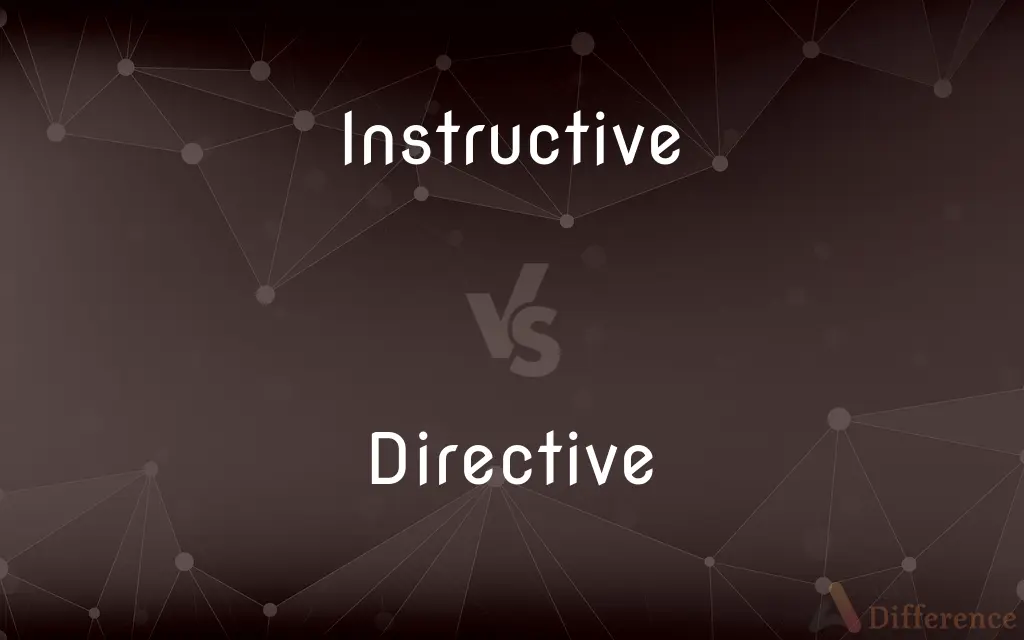Instructive vs. Directive — What's the Difference?
By Tayyaba Rehman & Maham Liaqat — Updated on April 6, 2024
Instructive content aims to educate by providing knowledge and insights, focusing on understanding, whereas directive content gives specific commands or guidelines, emphasizing action.

Difference Between Instructive and Directive
Table of Contents
ADVERTISEMENT
Key Differences
Instructive content is designed to enhance the reader's knowledge and skills through detailed explanations, examples, and clarifications. It encourages learning by understanding concepts and processes. Whereas directive content, often found in manuals or guidelines, focuses on telling the reader exactly what actions to take, leaving little room for interpretation.
In the realm of education, instructive materials might include textbooks or online courses that cover topics in depth, aiming to build a foundation of knowledge. On the other hand, directive materials are more about applying that knowledge, such as a lab manual telling students the steps to conduct an experiment.
In a workplace setting, instructive documents could be training modules that explain company policies, procedures, and the reasoning behind them, helping employees understand their roles and responsibilities. Conversely, directive documents might be memos or emails that instruct employees on specific actions they need to take, such as completing a task by a certain deadline.
In software documentation, instructive sections aim to make the user understand how the software works, providing a comprehensive overview of features and functionalities. In contrast, directive sections would guide the user through specific tasks, like installation or troubleshooting, with step-by-step instructions.
In customer service, instructive responses might explain why a problem occurred and how similar issues can be avoided in the future, empowering customers with knowledge. Directive responses, however, would tell the customer exactly what steps to follow to resolve their current issue, focusing on immediate action.
ADVERTISEMENT
Comparison Chart
Purpose
Educate and inform
Command or guide
Approach
Exploratory, encouraging understanding
Prescriptive, emphasizing action
Examples
Textbooks, educational videos
Manuals, procedural documents
Audience Engagement
Encourages questioning and deeper thought
Directs towards specific actions
Outcome
Broadened understanding, knowledge acquisition
Immediate action or compliance
Compare with Definitions
Instructive
Intended to impart knowledge or information.
The museum's exhibit was instructive, showcasing the history of aviation.
Directive
Specifying an action to be taken.
The directive email outlined all the steps required for compliance.
Instructive
Serving as a useful example.
The case study was instructive for understanding the business strategy.
Directive
Serving or intended to guide, govern, or influence.
The manager's directive was clear about the project's deadline.
Instructive
Helpful for learning or teaching.
Her instructive comments helped improve my writing skills.
Directive
Relating to the management or direction.
His role involved making directive decisions for the team.
Instructive
Providing useful information.
The instructive manual explained the device's features comprehensively.
Directive
An authoritative instruction.
Safety directives were issued to ensure everyone's wellbeing.
Instructive
Designed to educate.
Instructive videos on the platform made learning fun and engaging.
Directive
Guiding action or conduct.
The policy served as a directive for ethical decision-making.
Instructive
Conveying knowledge or information; enlightening.
Directive
An official or authoritative instruction
A new EC directive
Instructive
Conveying knowledge, information or instruction.
Well, that was an instructive lesson.
Directive
Involving the management or guidance of operations
The authority is seeking a directive role in energy policy
Instructive
(linguistics) A case in the Finnish and Estonian languages. It expresses the means or the instrument used to perform an action.
Directive
An order or instruction, especially one issued by an authority.
Instructive
Conveying knowledge; serving to instruct or inform; as, experience furnishes very instructive lessons.
In various talk the instructive hours they past.
The pregnant instructiveness of the Scripture.
Directive
Serving to direct, indicate, or guide.
Instructive
Serving to instruct of enlighten or inform
Directive
That which directs; serving to direct, indicate, or guide.
Instructive
Tending to increase knowledge or dissipate ignorance;
An enlightening glimpse of government in action
Directive
(grammar) Relating to the directive case.
Directive
An instruction or guideline that indicates how to perform an action or reach a goal.
Directive
(programming) A construct in source code that indicates how it should be processed but is not necessarily part of the program to be run.
Directive
An authoritative decision from an official body, which may or may not have binding force.
Directive
(European Union law) A form of legislative act addressed to the member states. The directive binds the member state to reach certain objectives in their national legislation.
Directive
(grammar) The directive case.
Directive
Having power to direct; tending to direct, guide, or govern; showing the way.
The precepts directive of our practice in relation to God.
Directive
Able to be directed; manageable.
Swords and bowsDirective by the limbs.
Directive
A pronouncement encouraging or banning some activity;
The boss loves to send us directives
Directive
Showing the way by conducting or leading; imposing direction on;
Felt his mother's directing arm around him
The directional role of science on industrial progress
Common Curiosities
Can a document be both instructive and directive?
Yes, many documents blend both to educate and then guide specific actions.
Where is directive content most commonly used?
In operational settings requiring specific actions, such as workplace procedures.
What is the main goal of instructive content?
To educate and provide knowledge, focusing on the reader's understanding.
In what settings is instructive content preferred?
Educational environments and any context where understanding is key.
Can instructive content include examples?
Yes, examples are often used to enhance understanding.
How does directive content benefit the reader?
It provides clear instructions for immediate action or compliance.
How do instructive and directive contents differ in approach?
Instructive is exploratory, while directive is prescriptive.
Are instructive materials always written?
No, they can also be videos, interactive tutorials, and more.
What makes instructive content effective?
Clear explanations, examples, and engaging the reader's curiosity.
Do directives need to be formal?
Not always, but clarity and authority are crucial.
Is directive content always brief and to the point?
Typically, yes, to ensure clear and unambiguous instructions.
How do audiences respond differently to instructive vs. directive content?
Instructive content invites engagement and thought, while directive content calls for action.
What is the significance of directive content in safety?
It provides crucial instructions that can prevent accidents and ensure safety.
Can instructive content be directive?
It can guide learning but usually does not command specific actions.
Why is it important to differentiate between instructive and directive content?
Understanding the distinction helps in creating appropriate materials for different needs and contexts.
Share Your Discovery

Previous Comparison
Wisdom vs. Maturity
Next Comparison
Humming vs. SingingAuthor Spotlight
Written by
Tayyaba RehmanTayyaba Rehman is a distinguished writer, currently serving as a primary contributor to askdifference.com. As a researcher in semantics and etymology, Tayyaba's passion for the complexity of languages and their distinctions has found a perfect home on the platform. Tayyaba delves into the intricacies of language, distinguishing between commonly confused words and phrases, thereby providing clarity for readers worldwide.
Co-written by
Maham Liaqat













































